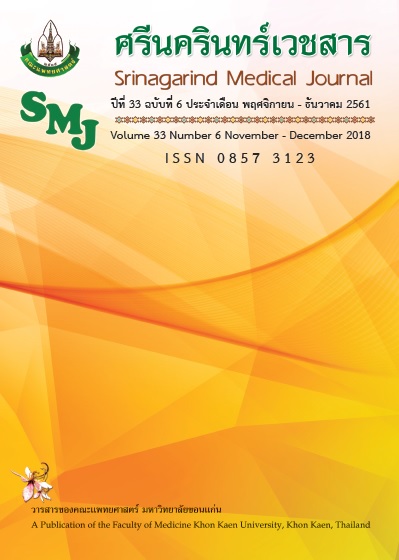The Association Between Antibiotics-Treated Patients in Roi Et Hospital and Their Risk of Infection with Extended Spectrum Beta-Lactamase Producing Escherichia coli (ESBL-E.coli)
Keywords:
Escherichia coli, Extended-spectrum β-lactamases, AntibioticsAbstract
Objective: To investigate the association between antibiotic-treated patients in Roi Et hospital and their risk of infection with extended spectrum beta-lactamase producing Escherichia coli ESBL-E.coli.
Methods: A hospital based case-controls study and data were collected from medical records of patients at Roi Et hospital between January 1, 2015 to December 31, 2017. Descriptive statistics, univariable analysis and multivariable analysis by multiple logistic regressions were used for data analysis. The statistically significant was set at p <0.05.
Results: Of 125 cases most of them were female 51.0% with mean age 63.2 +10.6 years. Whereas 250 controls most of them were male 55.0% with mean age 56.0 +11.4 years. The multiple logistic regressions analyzed revealed that patients treatment with carbapenems (OR Adj. =2.1; 95%CI: 1.98-4.41) and third generation cephalosporin (OR Adj. =3.2; 95%CI: 1.95-6.93) were risk factors of infection with ESBL-E.coli.
Conclusion: This study revealed the association of patients treated with either carbapenems and third generation cepahrosporin and their risks to be infected with ESBL-E.coli.
References
2. Curran KG, Heiman Marshall KE, Singh T, Doobovsky Z, Hensley J, Melius B, et al. An outbreak of Escherichia coli O157:H7 infections following a dairy education school field trip in Washington state, 2015. Epidemiol Infect 2018; 146: 442-9.
3. Lochan H, Pillay V, Bamford C, Nuttall J, Eley B. Bloodstream infections at a tertiary level paediatric hospital in South Africa. BMC Infect Dis 2017 ; 17: 750.
4. Ukah UV, Glass M, Avery B, Daignault D, Mulvey MR, Reid-Smith RJ, et al. Risk factors for acquisition of multidrug-resistant Escherichia coli and development of community-acquired urinary tract infections. Epidemiol Infect 2018; 146: 46-57.
5. Peirano G, Gregson DB, Kuhn S, Vanderkooi OG, Nobrega DB, Pitout JDD. Rates of colonization with extended-spectrum β-lactamase-producing Escherichia coli in Canadian travellers returning from South Asia: a cross-sectional assessment. CMAJ Open 2017; 5: E850–5.
6. Lukuke HM, Kasamba E, Mahuridi A, Nlandu RN, Narufumi S, Mukengeshayi AN, et al. [Nosocomial urinary tract and surgical site infection rates in the Maternity Ward at the General Referral Hospital in Katuba, Lubumbashi, Democratic Republic of the Congo]. Pan Afr Med J 2017; 28: 57.
7. Kotagiri P, Chembolli D, Ryan J, Hughes PD, Toussaint ND. Urinary Tract Infections in the First Year Post-Kidney Transplantation: Potential Benefits of Treating Asymptomatic Bacteriuria. Transplant Proc 2017; 49: 2070–5.
8. Ismail MD, Ali I, Hatt S, Salzman EA, Cronenwett AW, Marrs CF, et al. Association of Escherichia coli ST131 Lineage with risk of Urinary Tract Infection Recurrence among young women. J Glob Antimicrob Resist 2017; 3: 245-67
9. Zhang M, Xu Y, Jiang Z, Qian J, Zhang Z, Sun N, et al. [Study on risk factor of central venous catheter infection in ICU: 1 160 patients report]. Zhonghua Wei Zhong Bing Ji Jiu Yi Xue 2017; 29: 1082–6.
10. Chapelet G, Boureau AS, Dylis A, Herbreteau G, Corvec S, Batard E, et al. Association between dementia and reduced walking ability and 30-day mortality in patients with extended-spectrum beta-lactamase-producing Escherichia coli bacteremia. Eur J Clin Microbiol Infect Dis 2017; 36: 2417–22.
11. Saputra S, Jordan D, Mitchell T, Wong HS, Abraham RJ, Kidsley A, et al. Antimicrobial resistance in clinical Escherichia coli isolated from companion animals in Australia. Vet Microbiol 2017; 211: 43–50.
12. Lee H, Han SB, Kim JH, Kang S, Durey A. Risk factors of urinary tract infection caused by extended spectrum β-lactamase-producing Escherichia coli in emergency department. Am J Emerg Med 2018: 1608-12.
13. Narksawat K, Danchaivijitr S, Siripanichgon K, Rongrungrueng Y. Risk factors for multi-drug resistant Acinetobacter baumannii nosocomial infection. J Med Assoc Thai 2007; 90: 1633–9.
14. Pouladfar G, Basiratnia M, Anvarinejad M, Abbasi P, Amirmoezi F, Zare S. The antibiotic susceptibility patterns of uropathogens among children with urinary tract infection in Shiraz. Medicine (Baltimore) 2017 ; 96: e7834.
15. Namikawa H, Yamada K, Fujimoto H, Oinuma K-I, Tochino Y, Takemoto Y, et al. Clinical Characteristics of Bacteremia Caused by Extended-spectrum Beta-lactamase-producing Escherichia coli at a Tertiary Hospital. Intern Med Tokyo Jpn 2017; 56: 1807–15.
16. Nisha KV, Veena SA, Rathika SD, Vijaya SM, Avinash SK. Antimicrobial susceptibility, risk factors and prevalence of bla cefotaximase, temoneira, and sulfhydryl variable genes among Escherichia coli in community-acquired pediatric urinary tract infection. J Lab Physicians 2017; 9: 156–62.
17. Patel HB, Lusk KA, Cota JM. The Role of Cefepime in the Treatment of Extended-Spectrum Beta-Lactamase Infections. J Pharm Pract 2017; 897190017743134.
18. Søgaard M, Heide-Jørgensen U, Vandenbroucke JP, Schønheyder HC, Vandenbroucke-Grauls CMJE. Risk factors for extended-spectrum β-lactamase-producing Escherichia coli urinary tract infection in the community in Denmark: a case-control study. Clin Microbiol Infect 2017; 23: 952–60.
19. Xu M, Fan Y, Wang M, Lu X. Characteristics of Extended-Spectrum β-Lactamases-Producing Escherichia coli in Fecal Samples of Inpatients of Beijing Tongren Hospital. Jpn J Infect Dis 2017; 70: 290–4.
20. Arslan H, Azap OK, Ergönül O, Timurkaynak F, Urinary Tract Infection Study Group. Risk factors for ciprofloxacin resistance among Escherichia coli strains isolated from community-acquired urinary tract infections in Turkey. J Antimicrob Chemother 2005; 56: 914–8.
21. Calbo E, Romaní V, Xercavins M, Gómez L, Vidal CG, Quintana S, et al. Risk factors for community-onset urinary tract infections due to Escherichia coli harbouring extended-spectrum beta-lactamases. J Antimicrob Chemother 2006; 57: 780–3.
22. Wu UI, Yang CS, Chen WC, Chen YC, Chang SC. Risk factors for bloodstream infections due to extended-spectrum beta-lactamase-producing Escherichia coli. J Microbiol Immunol Infect 2010; 43: 310–6.
23. Meier S, Weber R, Zbinden R, Ruef C, Hasse B. Extended-spectrum β-lactamase-producing Gram-negative pathogens in community-acquired urinary tract infections: an increasing challenge for antimicrobial therapy. Infection 2011; 39: 333–40.
24. Merino I, Shaw E, Horcajada JP, Cercenado E, Mirelis B, Pallarés MA, et al. CTX-M-15-H30Rx-ST131 subclone is one of the main causes of healthcare-associated ESBL-producing Escherichia coli bacteraemia of urinary origin in Spain. J Antimicrob Chemother 2016; 71: 2125–30.



